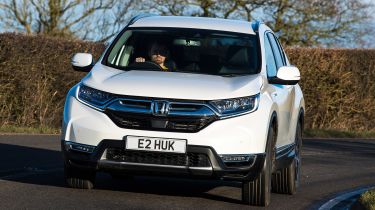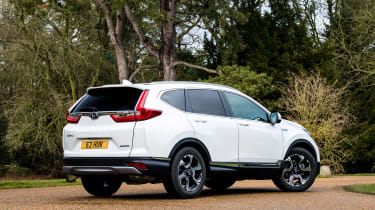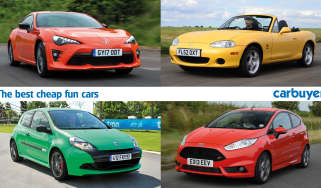Honda CR-V SUV - Engines, drive & performance (2018-2023)
The steering and suspension are an improvement
Honda has made significant improvements to the way the CR-V drives, replacing its steering system so feedback is much sharper, with a 26% reduction in turning the wheel from lock to lock compared to the old model. It's much better than the vague feeling of the old car and the suspension is capable of dealing with British roads, soaking up potholes, and refusing to jolt or feel too crashy.
The trade-off for the CR-V’s better ride is increased roll when cornering, along with the car tilting forwards and backwards whenever you brake or accelerate; Honda has put its emphasis on comfort rather than outright handling. If you prefer a sportier driving experience from your SUV, a Ford Kuga, Mazda CX-5 or BMW X1 is a better bet. The CR-V comes into its own on the motorway, however – there’s a great view ahead thanks to the high driving position and there’s barely any wind or engine noise when on the move.
Hybrid engine
The CR-V is now sold exclusively with a hybrid powertrain, first replacing the diesel that’s been part of the CR-V range until the latest version was announced, and now the 1.5-litre petrol engine as well. It's powered by a 2.0-litre i-VTEC petrol engine and two electric motors, the combination of which produces up to 181bhp. In this model, 0-62mph takes 8.8 seconds (just over nine seconds with all-wheel drive fitted) but the top speed is limited to 112mph
There are no gearchanges, so the hybrid CR-V offers very smooth acceleration, making it easy to drive around town. There are steering wheel-mounted paddles, but these adjust the level of energy recuperation instead of changing gear like in some other models with an automatic transmission. Driving modes affect how the CR-V behaves, allowing the driver to select electric driving, a hybrid mode or one in which the petrol engine does most of the work. There's also a sport mode for increased throttle response but in practice we didn't find the SUV felt much different.
More reviews
Despite offering a reasonable 0-62mph time, the CR-V can feel a bit underpowered at times, and while its linear acceleration is somewhat EV-like, this is accompanied by a drone from the engine and CVT gearbox.
Honda CR-V petrol engine
We've been impressed with Honda's 1.5-litre turbocharged VTEC petrol engine in the Civic, rating it as one of the best family hatchbacks to drive. However, the same engine wasn't quite as enjoyable here, because while it allowed relaxed cruising, you'd need to summon its power more frequently and it could become fairly loud. The CVT automatic felt a little smoother than the manual in this regard; the engine in the manual proved slightly louder again. However, the CVT didn't like to be rushed; it was best treated with gentle throttle inputs that suited the car’s relaxed demeanour.
Power from the 1.5-litre varied slightly depending on which gearbox you chose, with the manual getting 171bhp and the CVT version 187bhp and slightly more torque. Due to the four-wheel-drive system and automatic gearbox, the smaller engine was actually quicker - it takes 9.3 seconds to get from 0-62mph and has a top speed of 130mph, compared to 9.8 seconds and a 124mph top speed for the 187bhp version.













